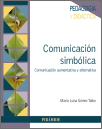Reseña del libro: Comunicación simbólica: Comunicación aumentativa y alternativa
Editorial Pirámide, 2020. ISBN papel: 978-84-368-4222-7 - ISBN ePub.: 978-84-368-4223-4
DOI:
https://doi.org/10.17979/reipe.2020.7.1.6353Palabras clave:
comunicación aumentativa y alternativa, comunicación no verbal, trastornos de la comunicaciónResumen
Este manual presenta un marco teórico, así como pautas para la evaluación y la intervención basados en la literatura más reciente sobre comunicación aumentativa y alternativa (CAA). Está compuesto por siete capítulos en los que destaca el énfasis sobre cómo conseguir la comunicación por encima de herramientas concretas, y se ofrecen técnicas, instrumentos y programas relevantes que están basados en buenas prácticas y que se describen en detalle. El manual resulta de clara utilidad para estudiantes y profesionales que trabajan en este campo, constituyendo una referencia obligada y actualizada en la literatura en español sobre CAA.
Descargas
##plugins.generic.pfl.publicationFactsTitle##
##plugins.generic.pfl.reviewerProfiles## N/D
##plugins.generic.pfl.authorStatements##
Indexado: {$indexList}
-
##plugins.generic.pfl.indexedList##
- ##plugins.generic.pfl.academicSociety##
- N/D
- Editora:
- Universidade da Coruña, Servizo de Publicacións
Citas
McNaughton, D. Y Light, J. (2013). The iPad and mobile technology revolution: Benefits and challenges for individuals who require augmentative and alternative communication. Augmentative and Alternative Communication, 29(2), 107-116. https://doi.org/10.3109/07434618.2013.784930
McNaughton, D. y Light, J. (2015). What we write about when we write about AAC: The past 30 years of research and future directions. Augmentative and Alternative Communication, 31(4), 261-270. https://doi.org/10.3109/07434618.2015.1099736
Sotillo, M. (2003). Sistemas alternativos de comunicación. Madrid: Trotta.
Torres, S. (2001). Sistemas alternativos de comunicación. Manual de comunicación aumentativa y alternativa: sistemas y estrategias. Madrid: Ediciones Aljibe.

Descargas
Publicado
Cómo citar
Número
Sección
Licencia
Los trabajos publicados en esta revista están bajo una licencia Creative Commons Reconocimiento-CompartirIgual 4.0 Internacional.
Los/as autores/as son los titulares de los derechos de explotación (copyright) de su trabajo, pero ceden el derecho de la primera publicación a la Revista de Estudios e Investigación en Psicología y Educación, la cual podrá publicar en cualquier lengua y soporte, divulgar y distribuir su contenido total o parcial por todos los medios tecnológicamente disponibles y a través de repositorios.
Se permite y anima a los/as autores/as a difundir los artículos aceptados para su publicación en los sitios web personales o institucionales, antes y después de su publicación, siempre que se indique claramente que el trabajo está en esta revista y se proporcionen los datos bibliográficos completos junto con el acceso al documento, preferiblemente mediante el DOI (en caso de que sea imprescindible utilizar un pdf, debe emplearse la versión final maquetada por la Revista). En el caso de artículos que provengan de estudios o proyectos financiados, esto se hará en los plazos y términos establecidos por la entidad o entidades financiadoras de la investigación publicada.



